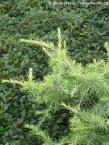Juniperus x pfitzeriana 'OLD GOLD'

Juniperus x pfitzeriana 'OLD GOLD'
Pfitzer juniper
Pfitzer juniper
| SIZE/TYPE | medium-sized shrub |
|---|---|
| USUAL HEIGHT | 0.5-1m |
| USUAL WIDTH | 1.5-2.5m |
| LEAVES | evergreen conifer |
| COLOUR OF LEAVES |
 + + multicoloured:yellow and light green multicoloured:yellow and light green |
| FLOWERS | insignificant or non-blooming |
| LOCATION | full to partial sun |
| USDA zone (lowest) | 4 (down to -34°C) |
| WINTER PROTECTION | |
| FOR ZONE 5+6 |

|
| FOR ZONE 7 |

|
| BELONGS TO CATEGORIES | Conifers |
Pfitzer juniper has an interesting story of its origin. In 1860’s French missionary and botanist David Armand collected seeds of juniperus sabina and juniperus chinensis in northern China. Apparently he lost all of his notes but the seeds somehow ended up a French nursery Metz under a different name, where they were used for crossbreeding. Some time later, in 1890’s a German botanist Wilhelm Pfitzer hybridized some of the French plants, and eventually came up with a plant so unique that he suggested to take it down as a new species. Some hundred years later modern science confirmed his findings by exploring the plant’s DNA. His plant was called “Pfitzeriana” and this name is now accepted for all other varieties belonging to this species.
Old Gold is an old juniper variety, indeed. It was introduced already in 1958. It is a typical example of Pfitzer juniper, making soft branches ascending at an angle of about 45° with bended tips. Old Gold juniper has the brightest foliage colour of all. The small, scale-like leaves are of rich yellow colour that turns golden in winter with minimum brown shades. It grows moderately, forming a flat-topped shrub, about 1m tall and 2.5m wide in full maturity (20-30 years). Its tiered foliage and horizontal spread calls for mixing it with plants of vertical habit.
It can be pruned, trimmed, and shaped in any way, it even withstands hard pruning into old wood. Pfitzer juniper will grow in almost any soil, sun or partial shade under the trees, and once established it takes long periods of drought. It is hardy to about -34°C (USDA zone 4), and is suitable for growing in outdoor pots.
Last update 15-01-2013
Old Gold is an old juniper variety, indeed. It was introduced already in 1958. It is a typical example of Pfitzer juniper, making soft branches ascending at an angle of about 45° with bended tips. Old Gold juniper has the brightest foliage colour of all. The small, scale-like leaves are of rich yellow colour that turns golden in winter with minimum brown shades. It grows moderately, forming a flat-topped shrub, about 1m tall and 2.5m wide in full maturity (20-30 years). Its tiered foliage and horizontal spread calls for mixing it with plants of vertical habit.
It can be pruned, trimmed, and shaped in any way, it even withstands hard pruning into old wood. Pfitzer juniper will grow in almost any soil, sun or partial shade under the trees, and once established it takes long periods of drought. It is hardy to about -34°C (USDA zone 4), and is suitable for growing in outdoor pots.
Last update 15-01-2013
SIZES and PRICES
CURRENTLY SOLD OUT
GLOSSARY
|










